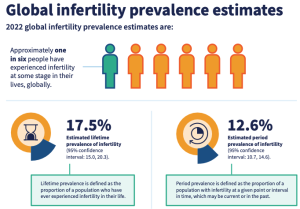
Infertility is a disease of the male or female reproductive system, defined by the failure to achieve a pregnancy after 12 months or more of regular unprotected sexual intercourse. It can cause significant distress, stigma, and financial hardship, affecting people’s mental and psychosocial well-being.
Despite the magnitude of the issue, solutions for the prevention, diagnosis and treatment of infertility – including assisted reproductive technology such as in vitro fertilization (IVF) – remain underfunded and inaccessible to many due to high costs, social stigma and limited availability.
At present, in most countries, fertility treatments are largely funded out of pocket – often resulting in devastating financial costs. People in the poorest countries spend a greater proportion of their income on fertility care compared to people in wealthier countries. High costs frequently prevent people from accessing infertility treatments or alternatively, can catapult them into poverty as a consequence of seeking care.
“Millions of people face catastrophic healthcare costs after seeking treatment for infertility, making this a major equity issue and all too often, a medical poverty trap for those affected,” said Dr Pascale Allotey, Director of Sexual and Reproductive Health and Research at WHO, including the United Nations’ Special Programme of Research, Development and Research Training in Human Reproduction (HRP). “Better policies and public financing can significantly improve access to treatment and protect poorer households from falling into poverty as a result.”
While the new report shows convincing evidence of the high global prevalence of infertility, it highlights a persistent lack of data in many countries and some regions. It calls for greater availability of national data on infertility disaggregated by age and by cause to help with quantifying infertility, as well as knowing who needs fertility care and how risks can be reduced.
About the report
This report provides insight into global and regional infertility prevalence by analyzing all relevant studies from 1990 to 2021, taking into account different estimation approaches used.
The search identified 12 241 records of potentially relevant studies across the world. Screening of these records led to the selection of 133 studies that were included in the analysis for the report. From these, relevant data points were used to generate pooled estimates, for lifetime and period infertility prevalence.
New research on fertility treatment costs
Separately, new research funded by HRP and WHO and published in the journal Human Reproduction Open assessed the costs associated with infertility treatments in low and middle-income countries. This analysis found that the direct medical costs paid by patients for a single round of in vitro fertilization (IVF) are often higher than the average annual income – indicating prohibitive costs for most people in these parts of the world.
This research can be accessed at: https://academic.oup.com/hropen/article/2023/2/hoad007/7066921
Source- https://www.who.int/



